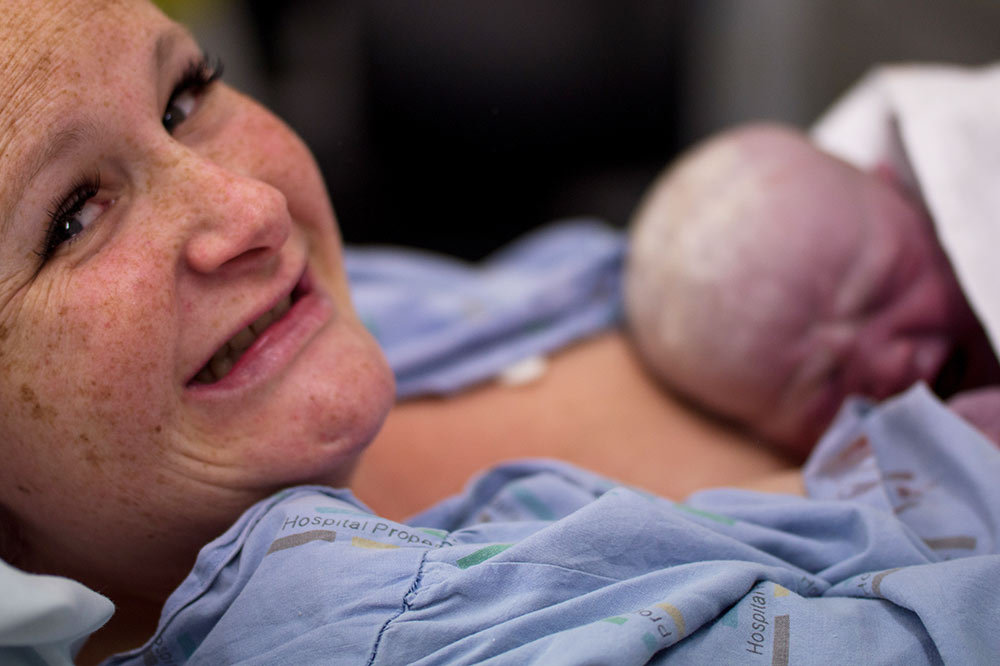Gentle C-Sections

This “family-centered” approach offers birthing parents a more meaningful C-section experience.
Medical Experts: William Camann, MD; Jill Doyle, CNM
Dressed in a thin paper gown, you nervously look up at your partner, who squeezes your hand as your doula leads you through calming breaths. Your playlist switches over to a Katy Perry song and you think, Yes—bring it. I am a firework.
Next thing you know, you see your sweet, scrunched-up baby emerging and then their wet little body is placed on your chest. Your heartbeat and theirs, seemingly one again.
Think this kind of experience is only for women having vaginal births? Think again.
The “gentle cesarean section (C-section),” also called a “family-centered C-section,” is bringing a better birth experience to the operating table—one that focuses on making the delivery safe and special for the family.
What is a Gentle C-Section?
In the early 2010s, when William Camann, MD, director of obstetric anesthesiology at Brigham and Women’s Hospital in Boston, observed transparent drapes being used in other types of surgeries—to enhance communication between the anesthesiologist and the surgeon—it sparked an idea: Why not use them in cesareans, so parents can see their babies being born?
For some expectant moms, C-sections can make them feel cheated out of the puffing, pushing, seeing-my-baby-take-their-first-breath moments or getting the chance to bond right after delivery. So, in an effort to help make the C-section experience feel more personal, Dr. Camann and his colleagues started incorporating transparent drapes and other practices to make the environment feel less intimidating and more family-friendly.
In an article for the University of Texas Southwestern Medical Center (UT Southwestern), Robyn Horsager-Boehrer, MD, OB-GYN, shares some of the ways they put this into practice, such as letting parents choose music to play in the operating room (OR), making sure birthing parents and their support person are introduced to everyone in the room, keeping the noise in the OR down to a minimum, and allowing for skin-to-skin contact between mom and baby as quickly as possible after birth. In fact, Dr. Camann says, “Once the pediatrician checks the newborn, the little one can be on mom’s skin immediately or within minutes,” as opposed to the 45 minutes (or longer) it can take in a traditional C-section.
Many parents who have opted for a gentle C-section have found the experience to be much more positive than they imagined. “When I first found out that I was going to have a C-section, I thought, They are just going to take [my baby] out of me, and I don’t get to be a part of the birth experience,” shares Jill Doyle, CNM, a mom of one and a certified nurse midwife practicing in Boston. “But with the family-centered C-section, I was a part of it, and I got to see [my baby being delivered], touch her, and know her.”
The Health Benefits of Gentle C-Sections
Besides making the big moment of your baby’s birth something you and your family can relish, gentle C-sections also have real medical benefits. For instance, one study found that complication rates for patients with gentle C-sections were the same or even lower than those who underwent traditional C-sections.
Not to mention, skin-to-skin contact after birth has been shown to benefit mom and baby in a number of ways beyond establishing a bond. Babies tend to get cold right after being born. When a mother holds her newborn against her chest, her body temperature will actually increase to keep her newborn warm. It’s a phenomenon called thermal synchrony.
This close cuddling also helps your newborn breathe better, reduces stress hormones, and decreases crying. Your wee one feels safe enough to relax.
When you get skin-to-skin time with your newborn, it can help establish breastfeeding, as well. Babies will naturally start making pushing movements toward an uncovered nipple, and then lick and root around before attempting to breastfeed. This usually happens around the first hour of life, but only if there’s nothing between you and your baby (i.e., no clothes or blankets).
“You can choose what you want and don’t want in a family-centered C-section,” Doyle explains. “For me, I really wanted to do skin-to-skin contact. I actually got to breastfeed my baby while they were finishing my C-section. It was just so special, and I was so grateful to have had that.”
Is a Gentle C-Section Right For You?
For most parents, a gentle C-section is a safe option. However, if your pregnancy has complications or if there’s any danger to you or your baby, it’s not recommended.
“Most C-sections are not complicated though—they are normal,” assures Dr. Camann. “Gentle C-sections can be done in multiple situations including twin deliveries, preeclampsia, and failure-to-progress labors.”
Although some OBs have been performing gentle C-sections for the last decade, it’s still a relatively new concept that some doctors still might not be familiar with. But that doesn’t mean your OB isn’t open to the procedure or unwilling to do it.
“It doesn’t require additional training. The modifications needed to do a gentle C-section are really pretty simple,” Dr. Camann says, “But the change it brings in the whole environment and the attitude in the operating room makes a big difference.”
If you like the idea of having a gentle C-section, ask your health care provider if this is something they offer or are willing to consider. During your conversation, go over the aspects of the procedure that are most important to you, like seeing your baby come out of the womb or getting immediate skin-to-skin contact.
“It’s really up to the patient to advocate for what they want,” encourages Doyle, adding, “You don’t just have to accept the way a traditional C-section is done.”







